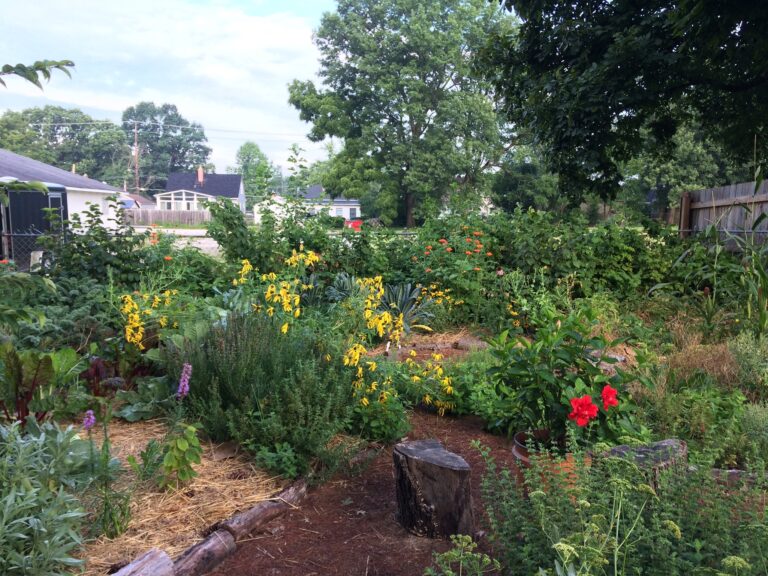March 7, 2023
Dianne Kadonaga lives in Linden, a neighborhood in northeast Columbus and is passionate about growing her own food, preserving what she can’t eat fresh, and sharing her knowledge with her neighbors. Dianne owns Sunny Glen Garden where she offers educational programs on how to convert lawns into edible forest gardens and wildlife habitat using permaculture and regenerative practices to increase biodiversity, soil health, and climate change resilience. She sells locally sourced, organic and heirloom seeds and plants for a variety of perennial fruits, forest vegetables and medicinals, and flowers native to Ohio. Dianne is also coordinator of Connecting Community Corridor for People, Pollinators and the Planet (or CCC for PPP), a neighborhood project involving 40 + families, churches, and businesses in Linden that are planting native heirlooms and pollinator plants in the community. Dianne is one of many “community voices” we heard from as part of our series to highlight neighbors in central Ohio communities that are making a difference in reducing food waste.
Where did your interest in growing food, preservation and food waste prevention come from?
My relationship with food developed from observation of my daily yoga and meditation practices that I started 20 years ago when I was in my 40’s. Some days my practices felt fluid and easy; other days I was stiff and sore or my joints ached. I took note of how my body felt and what I ate the day before. Through the process of elimination, I shifted to a fresh plant-based diet with less processed food as that is when my body felt best and I felt more energized.
Within months, my doctor noticed an immediate improvement: no more diabetic indicators and a reduction of high blood pressure to within normal limits, conditions that are prevalent in my family and relatives. It took longer for the precancerous polyps to disappear, so it has been and continues to be a learning process as my body and activities change. Experiencing the direct connection of eating healthy fresh food with how good I felt, I took the next step and started growing it myself because it seemed like a more affordable way to have organic produce.
I didn’t realize how impactful growing my own food would be until COVID hit – I lost all my income sources, but unlike others in my Linden community, I was able to support myself and only had to go grocery shopping four times in that first year because most of my food came out of my edible forest garden.
What do you do at home to prevent food waste?
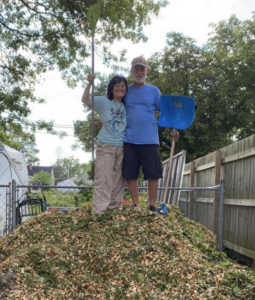
When I would purchase fresh food, it would sometimes go bad because I couldn’t see inside the container, or leftovers were pushed to the back of the fridge and forgotten. Telling myself I was going to do better wasn’t working, so I had to come up with tools and tricks for me that were convenient to implement to prevent wasting food.
Now, I label and date the containers with a pen I keep on the fridge, so I know what’s in them, or store them in glass jars so I can see what’s inside. The ones I want to use first are front and center on the top shelf so they are the first thing I see when I open the fridge.
I haven’t been able to get myself to plan meals ahead of time, so I just check the fridge and the garden and make my meals based on what’s available. I find it more interesting to look for recipe ideas with the ingredients I have and tweak them as needed since I’m almost always missing ingredients or don’t eat some of the items listed. It’s a fun adventure tasting new things and Stephen, my partner, is great at making things that I never thought would go together, taste delicious. There have been a few not so great tasting dishes too, but over time, this has become less of an issue. Seeing what we have and prioritizing what should be used sooner is how I make the most of what we have.
When harvesting from the garden, there’s often huge amounts of fresh produce maturing at once or when there is a discount at the store I buy in bulk to save money. My preference is eating freshly picked fruits and vegetables as that’s when they taste great and have the most nutrients. But excess berries, for example, can be frozen for later use in pies, jams, or drinks, blended into smoothies, or dehydrated and made into fruit leather for snacks to enjoy the rest of the year. I do the same with herbs – they can be used dried or chopped and frozen into ice cube trays in olive oil or ghee that I can throw in the pan when cooking, or add dried herbs or edible flowers into sugar or salt flavor mixes. I’ll also dry flowers or leaves for herbal teas. All of these provide added nutrients.
When it comes to my deep freezer, I keep the contents organized by last year and this year on a list so I can use it up in a timely way. When I pull food out, I cross off what I’ve taken so I always know what’s left. What’s wonderful about having a garden is that it is refreshed each year.
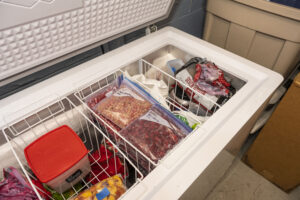
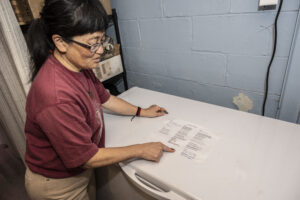
Growing my own food has given me a much better appreciation and awareness of what goes into it – from the tiny creatures in healthy soil, sunlight, and rain channeled along the swales to keep it watered, the vital pollinators to take it from flower to fruit, the birds that manage my pests. It takes time and labor to harvest and process the food but it is something I really enjoy. It seems too precious to waste after all that, but scraps can be composted and returned to fertilize the soil in the garden.
Use Save The Food’s Storage Guide & Freezing Guide for storing beans, nuts, fruits vegetables, dairy, pantry staples, meat and more!
What sort of food are you currently growing or planning to grow soon that you preserve?
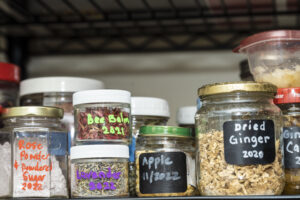
These are some of the edible food forest plants that will be coming back on their own this year (and every year). They create a forest edge from the tall canopy, subcanopy, shrub, bush, herbaceous, down to the ground cover, so can be packed in pretty intensively: acorn (oak), chestnut, apple, hazelnut, elderberry, red and black raspberries, a variety of currants and gooseberries, goji berries, blueberries, rosemary, sage, thyme, oregano, marjoram, lavender, savory, saffron, Virginia mountain mint, and bee balm, daylilies (edible flowers), red wine cap and shiitake mushrooms, strawberries, artichoke, asparagus, rhubarb, and sea kale – all of which can be preserved in different forms when they are ready to harvest. Most of them won’t start fruiting or coming out until after the end of April at the earliest. I just finished tapping the Silver Maple for sap to make maple syrup as it budded out early this year.
I also grow some annual plants (sunflowers, corn, cotton – for my oil lamp wicks for my daily yoga practice), nasturtium, squash and beans, basil, tulsi, and more, and have added subtropicals and tropicals because of climate change that have done really well in the edible forest garden: ginger, turmeric, taro, sweet potato as they are for my health and store well.
Download Dianne’s Vegan and Gluten-Free Lemon Balm & Rose Petal Mini Donut recipe here.
How do others in your household participate? 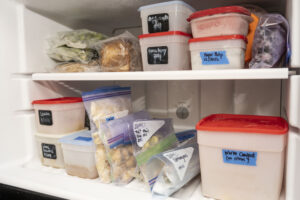
My son, Sam, enjoys the food we make at home and eats a lot, so there’s rarely any leftovers! Stephen doesn’t like anything going to waste, so he was actually the one who got us labeling and dating the leftovers, and he’s very creative at combining them into wonderful dishes. So we’ve been in this together – gardening, planting, processing, cooking, labeling food leftovers, and eating!
How did you get started composting?
Through the $50 rebate from the Community Backyards program, I was able to purchase a vermicomposter (worm bin) from the Urban Worm Farm. I keep it in my basement and feed the worms my food scraps for some beautiful, nutrient-dense fertilizer. My neighbor and I share also share a compost bin located between our houses that we use for our leaves. Between the worm and compost bin, I get a lot of nutrient-dense fertilizer to add to my garden beds every year.
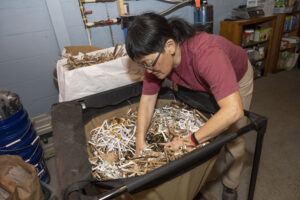
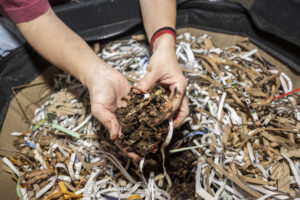
Apply for a SWACO-funded compost rebate through the Franklin Soil and Water District’s Community Backyards program.
Food Waste Prevention Takeaway Tips :
- Label containers with what’s in them and when it should be eaten by, or the date it was made.
- Keep things that need to be eaten soon front and center so you see them every time you open the fridge.
- Don’t be afraid to cook with leftovers – get creative with what’s in the fridge.
- Freeze or dry excess fruits, veggies and herbs rather than letting them rot.
- Organize chest freezers so you know where your oldest product is. Keep an inventory list and cross things out as they’re removed so you can track what’s left.
- Compost with worms. Worms bins are compact, can be made with materials laying around the house and offer a year-round opportunity to compost your food scraps in the comfort of your home.
- Get started composting at home. Download SWACO’s easy-to-use guide or watch our How-To Video.
Explore SaveMoreThanFood.org/make-a-difference/at-home to find tools and resources to help you reduce food waste.
